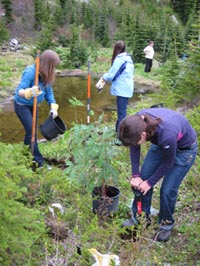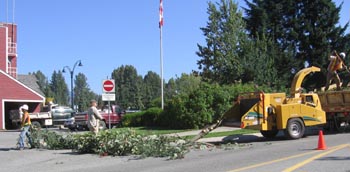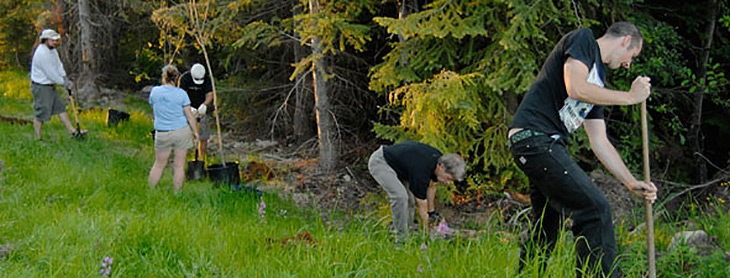Habitat Replacement
Where natural habitat has been degraded by human development, enhancing natural habitat in areas surrounding the development may be a good way to keep bears out of busy residential areas. This can be accomplished by thinning heavily wooded areas near natural travel corridors, allowing the sunlight to penetrate the thick forest and promote richer undergrowth. Parks, ski hills and golf courses often provide enhanced habitat for bears.
Native berry or nut producing trees and shrubs can also be planted, particularly those that produce fruit during the fall when other food sources have been depleted. This method is more sustainable over the long term than diversionary or intercept feeding. Once the initial resources (cost of plants and manpower to plant) have been incurred, the plants go on to naturally produce a food source every season. The drawback is that the plants will also fail with other natural foods during unfavourable weather conditions. While some government officials question the side effects of this method, suggesting that it artificially increases population size (enhancing the health of the general bear population, reducing starvation and increasing reproductive fitness); it could be argued that natural food sources (even when artificially planted) are still lower in calories than bird seed and garbage.
 In Whistler, BC mountain-ash (sorbus sitchensis) is being planted on the local ski hill away from human-use zones as a method of luring bears from the populated valley bottom and away from conflict with people during the late fall (when these berries naturally ripen) and when hyperphagia sets in (highest conflict period in most urban areas). This provides bears with a sufficient natural food source and allows them to feed away from areas where they may end up in conflict with people. Remember, bears will always choose a more secure feeding site so long as the food is sufficient to address their caloric needs.
In Whistler, BC mountain-ash (sorbus sitchensis) is being planted on the local ski hill away from human-use zones as a method of luring bears from the populated valley bottom and away from conflict with people during the late fall (when these berries naturally ripen) and when hyperphagia sets in (highest conflict period in most urban areas). This provides bears with a sufficient natural food source and allows them to feed away from areas where they may end up in conflict with people. Remember, bears will always choose a more secure feeding site so long as the food is sufficient to address their caloric needs.
Plant sites should be separated to allow for a variety of bears to feed in without getting in to conflict with each other. Sites should also consider availability of a fresh water source nearby. They need to be a good distance away from recreational use or residential areas.
Read about creating linear food plots to enhance wildlife habitat.
Removing bear-attractive landscaping from human-use areas
It is also important to remove berry producing trees and shrubs in areas where bears are not welcome, such as urban spaces and high use recreation sites.
 Artificially planted shrubs that produce berries, such as vaccinium spp, buffalo berries, mountain-ash and others, should be avoided in heavy bear-use areas. They should be removed or replaced with non-berry producing plants. At minimum, the ripe berries and fruit should be removed from plants. Priority areas include busy pathways, entrance-ways and children’s play areas.
Artificially planted shrubs that produce berries, such as vaccinium spp, buffalo berries, mountain-ash and others, should be avoided in heavy bear-use areas. They should be removed or replaced with non-berry producing plants. At minimum, the ripe berries and fruit should be removed from plants. Priority areas include busy pathways, entrance-ways and children’s play areas.
Our Mountain-ash trees at the base of Blackcomb compromised our conservation principals by encouraging bears into high traffic areas. Removal of these trees was the only suitable resolve. – Arthur DeJong, Environmental Resource Manager, Whistler Blackcomb Mountains
Here’s how Canmore reduced human-bear conflict by removing buffalo berry plants. Read a news article about it here.
Download our Professional’s Guide to Wildlife Friendly Landscaping; or our Resident’s Guide. Both guides were written for the Whistler, BC area in particular, but contain lots of great information for other areas as well. Keep in mind that plant species will vary from one area to another, so check with local experts to see which species to remove or plant in your area. Here’s a list of plants that are bear foods in Whistler.

